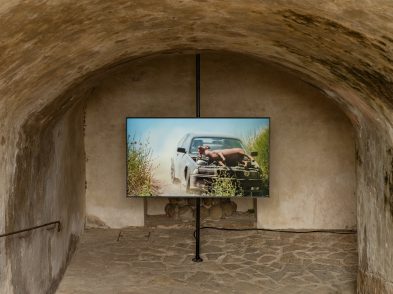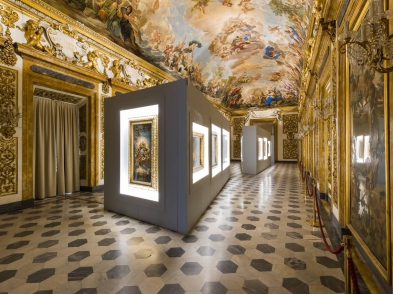Those who make, appreciate and promote contemporary art have long found
Florence a difficult place for new art: the competition with the magnificence
of its cultural past can be overwhelming. Yet two venues in Florence suggest
that contemporary art can find a home in Florence and that a curious public
does welcome these powerful messages.
The Ex3 Centre of Contemporary Art opened in 2009 with generous help
from the City of Florence to provide a permanent setting in which emerging
international talents can present a broad range of perspectives. Therefore, the
prospect of fresh insights offered by Ex3’s new look at artists from the so-called
BRIC countries is timely and exciting.
Brazil, Russia, India and China (BRIC): the economies of these countries
are growing much faster than those of the traditional G7, such as the United
States, Britain and Italy. (Indeed, many in the G7 are hoping that the rich
BRICs are going to fund their recoveries by buying their products and their
debt.) China, in particular, has stormed up the economic rankings and may soon
occupy the top spot.
It makes sense to spotlight, as Ex3 is doing in an ongoing series, the
concerns that artists from these nations, already establishing their
reputations at home and abroad, are expressing in their work.
Emerging from the first of these Ex3 shows is an atmosphere of unease.
When the two young Chinese photographers in Birdhead documented the process of
razing an entire residential district to accommodate an international expo
site, they summarised the dramatic change that speedy growth has brought to
Shanghai, scattering those who previously lived in densely packed communities.
Nonetheless, the duo’s black-and-white images and their accompanying video
diary remain remarkably objective about their subject. The nature of the
encounter, however, inevitably leaves the viewer asking searching questions.
Similarly, Russian Victor Alimpiev’s 2010 film Vot, in its first
showing in Italy, implies the tensions that arise between people out of harmony
but who seek agreement. Five actors stand close together as they speak over
each other’s words. Their effort to overcome the incoherence of the sounds resolves
only by chance, and then unsatisfactorily, when they say together vot,
the Russian word for ‘here.’
In spite of the immediate relevance of the BRIC theme, the combined
programme is sadly lacklustre, treating these sources of immense variety and
potential with a token presence. Throughout its two-month run, moreover, the
centre’s 600-square-metre central hall remains inexplicably closed, reducing a
huge idea to an uninviting fraction of the venue’s immense space. The hope is
that Ex3’s vigour will revive in the new year. If not, the packing cases used
as furniture in the entrance hall will seem fearfully prescient.
By contrast, BASE in via San Niccolò triumphs by inserting big names in
a small space. The initiative of a group of Florence-based artists, who also
largely finance it, BASE is both a meeting place for the progressive arts
community in Florence and Tuscany and a showcase in which the public can
encounter some of today’s most significant figures on the international visual
arts scene. The challenge to those invited to exhibit is to create a coherent
impression of what they do in a space no bigger than a neighbourhood newsstand.
This challenge has been met since BASE opened in 1998 with an
installation by American minimalist Sol LeWitt. The gallery’s ambition has not
dimmed since and it has hosted Robert Barry, Gino De Dominicis, Pedro Cabrita
Reis, Franz West, François Morrellet and Grazia Toderi, among many more names
that have also filled New York’s Guggenheim Museum or London’s Tate Modern.
The current show, Binfinito, is no exception. Rome-based artist Maurizio
Mochetti has exhibited at the Venice Biennale, represented Italy in major arts
festivals in Brazil, Australia and Japan and has a permanent installation in
Rome’s new MAXXI museum. The prevailing theme in his work is light. In his
hands, it becomes a physical presence dipping, rising and cutting across lofty
interiors to transform what seems at first empty architecture into a powerhouse
of directed energy.
Machete invariably generates an experience more cerebral than visual,
engaging the viewer’s mind in thoughts of the infinity of space surrounding us.
Using very simple means, he achieves a sensation of light powering into spaces
deeper than we can believe exist. At BASE, a spear-like rod appears to hang
unsupported between floor, wall and ceiling, angled upwards like a javelin
cutting through the air to a point far beyond the room itself.
In the second piece, an unseen line travels above head-height to stretch
between two walls. The only evidence of its presence are two black discs, which
the viewer might imagine are the poles the imaginary beam speeds between,
passing in its supposed trajectory through a hollow black tube hovering in
mid-air on barely visible wires.
Although both artworks date from the 1960s, their simplicity keeps them
up to date. Indeed, they could be survivals from the ancient world or
clean-lined, stripped-down trailblazers of cutting-edge technology. In this
way, a tiny cabinet space is transformed into an arena buzzing with
possibilities.
Unforgettable art does need not great buildings to impress itself on our
minds and memories. More important is the richness of an artist’s idea and the
willingness of audiences to help the work unfold by trusting their
imaginations. That is especially true of today’s art: it takes numerous forms
and enters unfamiliar territory with many more questions than answers. Ex3,
like the Strozzina at Palazzo Strozzi, offers a remarkable environment that
curators and artists are still learning to use to good effect. Meanwhile, BASE
with its tiny space and clear ambition proves that big surprises can come in
small packages.
Ex3 Centre of Contemporary Art
Viale Giannotti 81/83/85, tel. 055/6288966
Wednesday to Sunday, 11am to 7pm; www.ex3.it
Birdhead: New Village and Victor Alimpiev: Vot, until January 6, 2012
BASE, Progetti per l’Arte
Via San Niccolò 18r, tel.
328/6927778
Tuesday to Saturday, 6 to 8pm (or by appointment); www.BaseItaly.org
Binfinito, by Maurizio Mochetti,
until February 10, 2012






